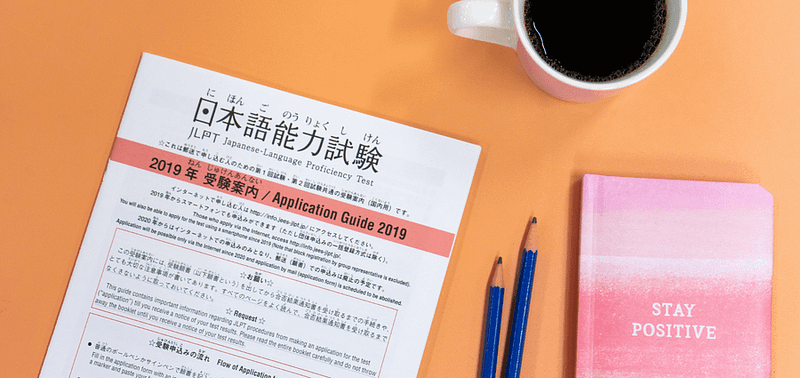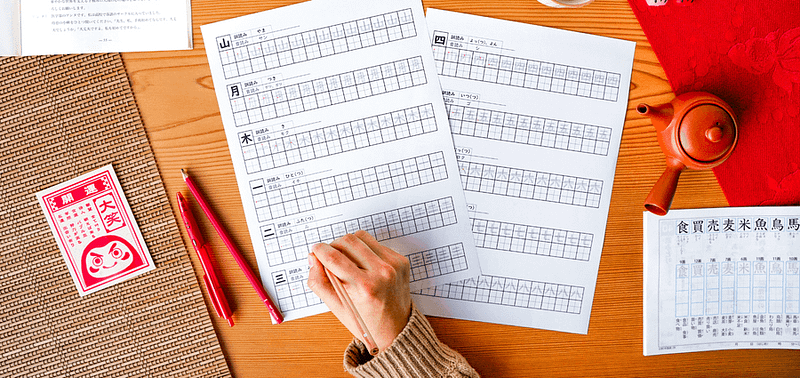Knowing how to best prepare for JLPT N1 is not obvious. This is because the jump from N2 to N1 is huge and can easily feel overwhelming if you don’t have a proper study plan. It’s not impossible, though, as long as you put in the hard work!
In this article, I will share my own experiences and tips & tricks for passing the JLPT N1.
About the JLPT
JLPT stands for “Japanese Language Proficiency Test” and is a standardized Japanese language test held twice a year. The test consists of multiple-choice questions which cover reading comprehension, listening comprehension, grammar, and kanji.
The JLPT ranges from N5 – N1 (N1 being the hardest). Furthermore, the difficulty curve is exponential, so the jump from N4 to N3 is roughly twice as hard as the one from N5 to N4. This means that going from N2 to N1 requires about as much studies as to go from N5 to N2.
According to the JLPT official website the description of N5 – N1 is as follows:
N5 – Able to understand basic Japanese to a certain degree.
N4 – Able to understand basic Japanese.
N3 – Able to understand Japanese used in everyday situations to a certain degree.
N2 – In addition to understanding Japanese used in everyday situations, be able to understand Japanese used in a wider range of situations to some extent.
N1 – Able to understand Japanese used in a wide range of situations.
Why is the JLPT important?
Japanese society highly values ganbar-ism (effort-ism) and not only is this mirrored in the educational system and the (in)famous national university entrance exams, but also in the importance of standardized tests such as the TOEIC (Test of English for International Communication) and the JLPT.
Having merits and diplomas to prove your abilities is common practice and the JLPT is widely recognized in Japan to be proof of your Japanese proficiency. Therefore passing the JLPT N1 is often recommended to work at a company or enter university.
Although N2 is the minimum requirement for most universities/workplaces, having passed N1 will make your resume more attractive. It will also give you a confidence boost when you have to produce academic papers or written reports.

My journey to passing the JLPT N1
My motivations for passing the JLPT N1 and learning Japanese in general were many. I wanted to better connect with Japanese people. I wanted to have the choice to study at university/work in Japan. I wanted to be able to enjoy Japanese literature and play games in Japanese.
When I first started studying for the JLPT, I was staying in Yokohama and studying at Yokohama Design College. At the time, I had studied Japanese for about 4 months and was recommended by our homeroom teacher to challenge myself to try and pass N3. And so, I and a few other classmates started studying after school, buying textbooks such as “日本語 総まとめN3” (Nihongo Sō-matome N3) and “Try! 日本語能力N3” (Try! Nihongo Nōryoku shiken N3) as well as crunching N3 mock exams provided by the school. We were also very lucky to have a teacher who, twice a week outside her own work time, voluntarily held extra classes just so that we would pass the N3 (Shoutouts to Sakuma sensei).
However, despite all the efforts, I still didn’t pass N3.
I had overestimated my ability and underestimated the difficulty of the test so I decided that I would increase my efforts and pass N2 at the next earliest opportunity, which was six months later.
What I did differently this time was that I started immersing myself in the Japanese language and performing my hobbies (watching movies, playing games) in Japanese rather than English.
I also made it a custom to always look up unfamiliar words and export them into Anki (A flashcard learning app). Then I used the same textbooks as mentioned above, but for N2, and studied for a couple of hours every day.
And, with some guidance from my teacher, I managed to pass N2!
After passing N2 I graduated from Yokohama Design College and returned back to Sweden. But for personal reasons I came back to Japan six months later. The easiest way to get a visa was to start studying at a Japanese language school again and so I entered the Intercultural Institute of Japan located in Akihabara.
During my one year at the Intercultural Institute of Japan I made it my goal to pass N1. According to my experience, the difference between N1 and N2 is that the texts are harder, and the questions are more open (for example, “what is the author’s intent with the text”). During the listening comprehension you also have to remember details and take notes while listening.
More than anything though, the difficult part is that there are just so many new words and kanji you must remember. You must learn all 2136 常用漢字 (jōyō kanji, the most commonly used kanji in Japanese) compared to the roughly 1000 kanji required for N2.
In total it took me two-and-a-half years to pass N1, and one-and-a-half years to get from N2 to N1. As you may imagine, it is hard to know where to begin studying. Therefore, I’m going to share my top three tips of what worked for me when I was preparing for N1.

My top 3 tips to studying for N1
Read, read, read!
If you are not into books, try reading newspapers, or playing games with a lot of text such as JRPGs (Japanese Role-Playing Games) or VNs (Virtual Novels). Reading is the best way to increase vocabulary and get familiar with grammatical patterns and new kanji. If you read enough, you will also develop an ability to tell if a sentence “sounds weird”. And this gut-feeling will help you pass N1.
Do a lot of N1 mock exams
When you feel like you are beginning to have a chance of passing JLPT N1, next I would recommend that you get familiar with the structure of the test. By doing a lot of mock exams, not only do you see what holes in your knowledge you need to fill, but you also learn what kind of curveballs will be thrown at you. Just remember to be honest with yourself and mark the questions that you are “guessing” at, so that you can review those questions too, even if you got them correct.
Make it a good habit to study kanji
To memorize over a 1000 new kanji and related vocabulary is no small feat. It is important to find a good structure for your studying. For this purpose, I recommend getting a kanji textbook, for example 留学生のための漢字の教科書 上級1000 (Ryūgakusei no tame no kanji no kyōkasho jōkyū 1000) and for each kanji, methodically write lists with Japanese words and their counterpart in your language. Writing the words by hand is very important as it makes you pay more attention, making it stick better. I also recommend starting each study session with first reviewing previously studied kanji. Repetition is key for making the new kanji and vocabulary enter the long-term memory.
No matter how you put it, passing the JLPT N1 requires diligent effort. However, passing N1 will not only open a lot of doors if you are planning to study at university or build a career in Japan, it will also help you understand more complex topics and help you connect on a deeper level with Japanese people.
Do you have any tips on how you studied for N1? Feel free to share your thoughts in the comments below!
For more tips on how to study Japanese, follow our blog to learn more!














